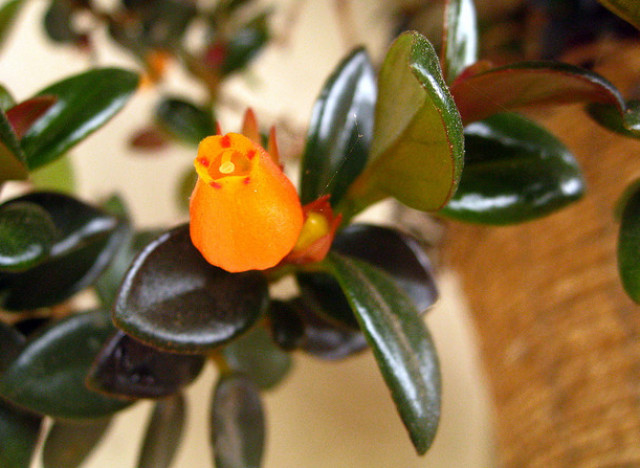The Nematanthus gets its common name of 'Goldfish Plant' because its flowers closely resemble the most commonly kept aquarium fish. Most of us can say that we had a goldfish at one point in our lives and now you can have many many more - in plant form! Its trailing leaves are small, defined and waxy and spread downward as it matures, sometimes reaching three feet long if left untrimmed. The petals create a pouch with a small opening that can bloom prolifically in shades of red, orange and yellow.

Photo by Flickr user Mike Souza.
Naturally grown in central and South America, they are generally epiphytic, meaning that they grow on other plants (but not parasitic). This requires them to get most of their moisture and nutrients from the air around them. Use a good potting soil that feels light for its volume which will allow water to freely drain. The goldfish plant is happiest on the slightly cooler side of normal home temperatures (65-75 degrees) but do not bring it down below 60 degrees. They want as many hours of bright filtered light per day as you are able to give it, while avoiding middle of the day direct sun rays. You might want to consider picking up a grow light during times of shorter daylight hours in order to give it what it really wants. Your plant might get leggy or curling leaves which is normally the product of not enough daylight. Pinch back the plant after it blooms to keep it bushy. The goldfish plant does thrive in humidity, so if your home is dry give it a regular misting or place it near a humidifier.
The main blooming seasons for the goldfish plant are spring and summer, and while in bloom it can be fed with a high phosphorus fertilizer that is cut in half from its recommended dosage. You can water your plant after the top inch goes dry being careful not to keep it wet- they do not like to be over watered. Then in winter, as temperatures get cooler, you will cut back your watering cycle.
As your plant gets larger, move it to a hanging container as to showcase its trailing nature. When transplanting, it's recommend to utilize a slightly larger container as to not give it too much space. They look best in light-colored, clean-lined containers in order to contrast the rich and deep-toned leaves. Stay away from selecting a container color that is similar to the hue of the flower, as you want the flowers to stand out. The goldfish plant, if treated properly, will give you an imaginative bloom on a regular basis, which I can assure you will not want to flush down the toilet.